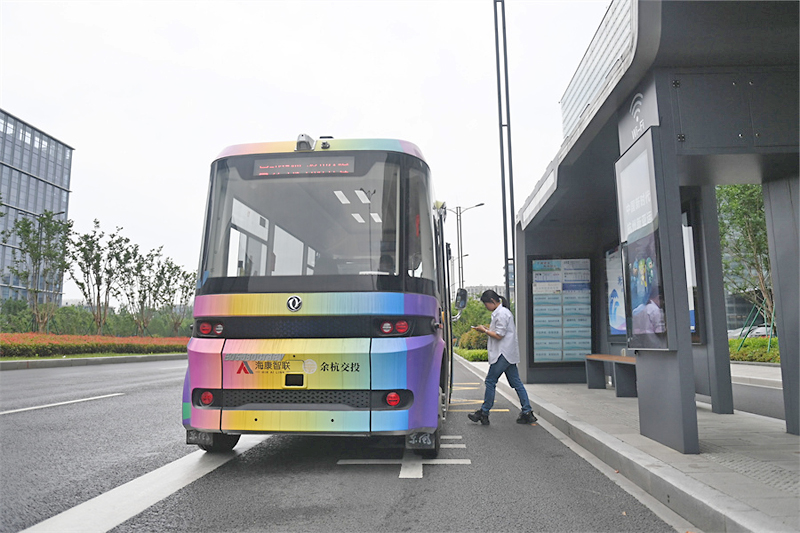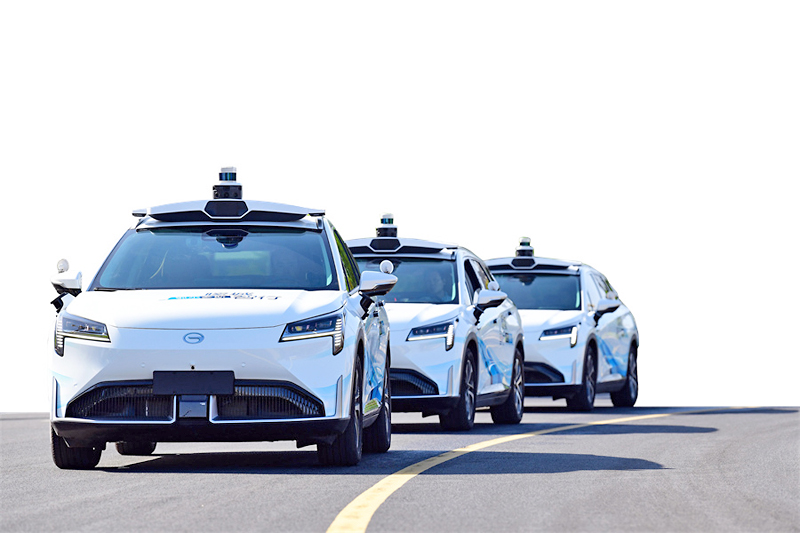HONG KONG – Driverless vehicles are now moving from science fiction movies to the streets of China’s cities, overcoming many challenges and uncertainties in an effort to make them part of everyday life.
The fast-growing technology first gained traction in China nearly a decade ago.
In 2015, Swedish car manufacturer Volvo tested a hands-free vehicle traveling at a speed of 70 kilometers per hour on Beijing’s Sixth Ring Road.
Chinese tech giant Baidu established its intelligent driving group in 2017, and launched the Apollo autonomous driving plan in the same year.
Pony.ai, founded by former Baidu engineers, established the first autonomous driving research and development center in 2016.



By the end of February, more than 20 cities had implemented policies supporting autonomous driving testing, granting licenses to more than 60 companies.
That progress was generally smooth until July, when a short video went viral on social media of one of Baidu’s Apollo Go driverless vehicles hitting a scooter in Wuhan, the capital of Hubei province.
Baidu immediately explained that the accident happened because the scooter driver ran a red light when the driverless vehicle started moving. Although the accident was minor, as shown in the footage, it sparked complaints from drivers and local residents.
The Chinese name for Apollo Go is Luobo Kuaipaowhich means ‘robot running fast’. But in Wuhan, it was called a ‘dumb robot’, as many recordings showed the robot having minor accidents.
A driverless vehicle was seen stopped in the middle of the road in front of an empty plastic bag, causing a traffic jam. In another video, two vehicles are seen braking to face each other, not knowing what to do next.
However, security issues are a real concern. When the vehicle in Wuhan failed to see the scooter, local residents began to doubt the safety and reliability of driverless vehicles, even though manufacturers have long claimed they are safer than human drivers.
At an event in May, Baidu’s vice president, Wang Yunpeng, noted that the number of insurance claims for Apollo Go vehicles in the past two years was a quarter of that of human drivers.
In the second quarter of this year, Apollo Go provided approximately 899,000 vehicles for passengers, an increase of 26 percent compared to the previous year. As of July 28, the number of trips provided to the public by Apollo Go exceeded 7 million, the company said in its latest financial results.
The safety level of autonomous driving is 10 times better than human driving, according to Pony.ai’s vice president, Zhang Ning.
The company has conducted 3.5 million kilometers of unmanned tests around the world until May this year.
However, a robot taxi does not have a quick solution when an injured passenger or road user needs help and has to wait until the operator sends someone to the location.
If the accident is minor, the insurance company may try to settle and offer a certain amount of money.
However, the issue becomes more complicated in the case of more serious accidents that cause injury or death that require a prison sentence.
COMPETITION
Taxi drivers also complain that robot taxi companies are stealing their customers by offering lucrative subsidies.
A receipt for a 64-minute 28km robot taxi ride in Wuhan showed that the fare was only 26.52 yuan, much cheaper than a regular taxi fare.
However, with closer observation, it shows that there is a discount of 109.52 yuan.
Wuhan has over 3,300 km of road that can be used for robot taxis, which is the longest in China. Robot taxis recorded 850,000 rides in the first half of this year, more than in all of 2023, according to a report Hubei Daily.
In July, an Apollo Go vehicle logged up to 20 trips in one day, the same number as a regular taxi, according to Shanghai-based news portal Jiemian.
There are around 400 Apollo Go vehicles in Wuhan, said Baidu CEO Robin Li.
“Our vehicles only account for 1 percent of the total number of taxis in Wuhan. It may take quite a long time, even years, to increase (the percentage),” Li said.
William Li, founder and CEO of NEV startup Nio, has sided with taxi drivers.
He stated that the purpose of technology such as smart driving is to reduce the burden of driving, and not to steal jobs from low-income earners.
“This is not a very inspiring story. We will never do a robot taxi,” he said.
Nio has invested heavily in driving assistance functions, and is one of the first car manufacturers in the world to use the latest Nvidia chips designed for such features.
Gu Dasong, executive director of Southeast University’s Center for Legal Research and Transportation Development, noted that robot taxis may reduce the need for commercial drivers, such as taxi drivers and couriers, to a certain extent in the long run.
However, the transition to robot taxis will profoundly change the labor market, with new job opportunities emerging from the service.
TRAFFIC SAFETY
Baidu points out that robot taxis, if applied at the city level, can solve problems such as traffic jams and traffic accidents.
However, as long as there are robot drivers and taxis on the road at the same time, congestion reduction and collision-free driving will not happen, analysts say.
Robot taxis tend to be good at obeying traffic rules and staying alert, but human drivers sometimes cut lanes and don’t always focus on road conditions, they added.
Zhang Xiang, an automotive analyst at China’s North University of Technology, said it would take at least 10 years for large-scale robot taxi business operations to become a reality.
Apart from the technological problems that need to be fixed, the robot taxis that are currently operating attract customers who are not in a hurry and want to experience something new.
Unlike regular taxis, they pick up and drop off passengers at fixed stops. They also have more conservative road safety rules and move slower than regular taxis.
BUSINESS OPPORTUNITY
Despite various problems, robot taxis will soon become commercially viable.
Baidu stated that with declining hardware costs and increased orders, Apollo Go is expected to reach profitability by 2025.
Apollo Go is losing nearly US$11,000 a year per vehicle in Wuhan, according to Haitong International Securities estimates.
Lower-cost driverless models could enable annual profits of nearly US$16,000 per vehicle, the securities firm said.
Chen Zhuo, Apollo Go’s general manager, said the company would be “the world’s first commercially viable autonomous driving platform.”
Pony.ai is also confident about the sector’s prospects. In a designated 160 square kilometer zone in Beijing’s E-Town, a national-level economic-technological development area, the company operates nearly 100 robotaxis.
Compared to a few years ago, the journey is now much smoother without sudden braking, and the vehicles operate in a similar way to other taxi services.
Pony.ai plans to increase the robotaxi fleet in each city tenfold by 2025 or 2026, said the company’s vice president, Zhang, in an interview with Xinhua. – ANN/China Daily

